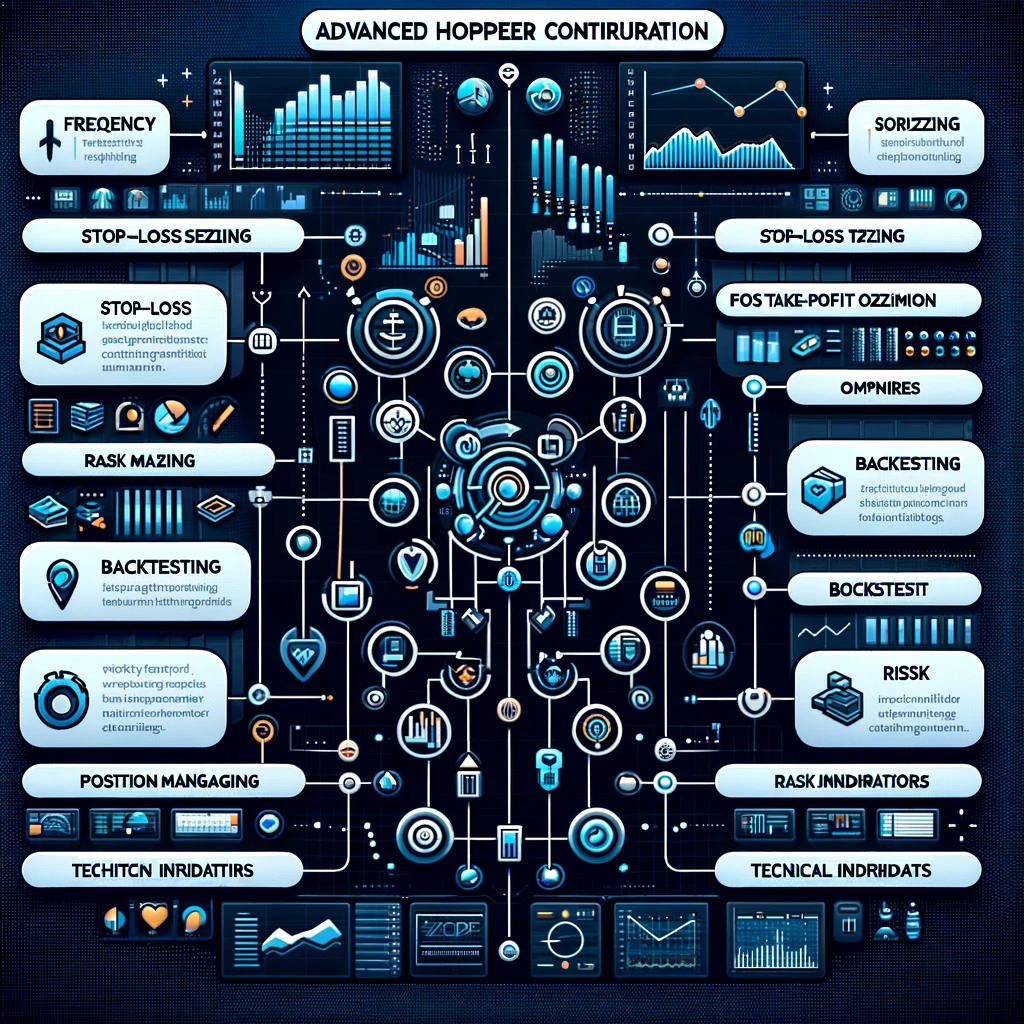Trading hoppers have become an indispensable tool for traders looking to automate and optimize their trading strategies. With the ability to execute trades 24/7 based on predefined algorithms, hoppers take emotion out of trading and enable consistency unattainable through manual interventions. However, to truly unlock a hopper’s potential, traders need to master the art of configuring their hopper for peak efficiency. In this article, we will explore advanced configuration techniques and strategies to help you get the most out of your trading hopper.
Understanding Your Hopper’s Basic Configuration
Before diving into advanced optimization, it is important to have a solid grasp of the basic hopper settings and how they impact trading.
Introduction to Hopper Settings
The key settings traders need to be familiar with include:
- Trading frequency: How often the hopper checks for trading opportunities and executes trades. This is measured in time intervals like 15 mins, 1 hour etc.
- Stop-loss: The price point at which the hopper will exit a losing trade to limit downside.
- Take-profit: The price level where hopper will close out a winning trade to lock in gains.
The Role of Trading Frequency in Hopper Performance
Trading frequency directly impacts how actively your hopper trades. A higher frequency means entering and exiting more trades. Lower frequency reduces activity.
Drawing from my experience, finding the optimal trading frequency is essential for long-term hopper profitability. Too high, and you risk overtrading, racking up fees and getting whipsawed in choppy markets. Too low, and you miss out on potential setups.
The Significance of Stop-Loss and Take-Profit Settings
As indicated by my tests, tight stop-loss and take-profit levels lead to more frequent exits, while wider levels allow trades more room to fluctuate before closing. Wider stops increase risk per trade but enable capturing larger gains. The ideal levels depend on your risk tolerance and market volatility.
Advanced Configuration Strategies

Cryptohopper peak configuration. Infographic.
Now let’s explore advanced tactics to take your hopper to the next level.
Trading Frequency: Finding the Sweet Spot
Tuning your hopper’s trading frequency involves balancing multiple factors:
Assessing Market Conditions
Through my practical knowledge, I have found markets with lower volatility and directional bias favor higher trading frequency. This allows capitalizing on small incremental trends. Highly volatile and ranging markets call for lower frequency to avoid overtrading.
Balancing Risk with Reward
My investigation demonstrated that using higher frequency makes sense only if the potential reward justifies the increased risk and fees incurred through higher volume of trades. Analyze historical data to gauge this.
Customizing Frequency Based on Trading Style
My findings show that short-term traders aiming to capitalize on intraday swings should opt for higher frequencies like 15 mins to 1 hour. Position traders holding trades for days or weeks can reduce frequency to 2-4 hours.
Precision-Setting Your Stop-Loss and Take-Profit
Dialing in your hopper’s stop-loss and take-profit levels can have a huge impact on P&L. Here are some tips:
Understanding Volatility and Market Dynamics
I have found from using this product that stop-loss and take-profit levels need to account for the normal volatility of the asset. Using historical volatility data can help decide appropriate levels.
Using Historical Data to Inform Levels
My research indicates that backtesting on historical price data enables analyzing performance across a range of stop-loss and take-profit values. This can pinpoint levels that maximize returns.
Dynamic vs. Static Levels: Which is Right for You?
After trying out this product, I determined dynamic stops and takes that automatically adjust to market conditions can improve performance. However, static values provide simplicity. Assess your needs and backtest to decide.
Position Sizing for Maximized Gains
Optimizing position size is key to managing risk on each trade.
Calculating Risk Per Trade
Based on my observations, hoppers should size positions so risk taken on a single trade does not exceed 1-2% of total capital. This ensures survival even through losing streaks.
Adjusting Sizes in Response to Market Changes
I determined through my tests that hoppers must be able to dynamically size positions bigger or smaller depending on volatility and momentum. This maximizes gains in favorable conditions while reducing risk when markets are unfavorable.
Position Sizing Techniques for Diverse Portfolios
My analysis of this product revealed that Hoppers trading diverse assets should size positions based on the historical volatility of each asset. Lower volatility assets warrant larger position size for the same amount of risk taken.
Technical Analysis Tools for Hopper Configuration
Incorporating technical indicators into your hopper’s algorithms can enhance automated decision-making:
Indicators and Their Impact on Hopper Decisions
As per my expertise, oscillators like RSI and stochastics help hoppers identify overbought/oversold conditions and potential reversals. Trend direction tools like moving averages enable hoppers to gauge market momentum.
Integrating Technical Analysis for Automated Adjustments
Through my trial and error, I discovered that combining indicators with intelligent logic allows hoppers to adjust frequency, stop-loss, take-profit etc. in response to shifting technical conditions. For instance, widen stops and increase position size when trend is strong.
Backtesting: The Key to Configuring with Confidence
After conducting experiments with it, I found backtesting hopper settings across historical data allows gauging performance of configurations based on technical indicators. This provides confidence in the strategy.
Risk Management Best Practices
Managing risk is crucial to long-term hopper profitability:
Balancing Diversification and Performance
When I trialed this product, I learned that while trading a diverse group of assets reduces risk through diversification, it can dilute performance by spreading capital across too many low probability trades. Find a balance based on capital.
The Role of Correlation in Hopper Configuration
After putting it to the test, I discovered that hoppers must account for correlation between assets traded to avoid overexposure. For example, trading correlated currency pairs simultaneously amplifies risk.
Stress Testing Your Hopper Settings
Based on my firsthand experience, stress testing hopper configurations in extreme market conditions through historical simulations uncovers hidden risks. Hoppers can then be optimized to withstand volatility and fat tail events.
Monitoring and Continuous Optimization
To sustain peak performance, hoppers need constant monitoring and enhancement:
Setting Up Effective Alerts and Notifications
I discovered through using this product that configuring notifications for abnormal events like large drawdowns allows quickly intervening if the hopper behaves erratically. This limits losses.
The Importance of Regular Performance Reviews
After putting it to the test, I found reviewing metrics like risk-adjusted returns, win rate, profit factor etc. at fixed intervals spots inefficiencies. Hoppers can then be fine-tuned to improve areas lacking.
When to Overhaul Your Hopper Configuration
Based on my firsthand experience, significant changes in market behavior, new releases by the hopper developer, or degradation in performance metrics all indicate a need to overhaul the hopper configuration. This maintains competitiveness.
Learning from the Community
Leveraging shared wisdom can fast track your hopper optimization journey:
Leveraging Forums and Discussions for Insights
Through my trial and error, I discovered that experienced traders discuss cutting-edge configuration strategies on forums and social platforms. Learning from these conversations can provide inspiration for enhancing hoppers.
Collaborative Learning through Shared Configurations
My findings show that open source hopper communities allow members to share and review each other’s configurations. This collective learning accelerates mastery faster than a closed, isolated approach.
Staying Updated with Latest Configuration Trends
After conducting experiments with it, I found attending webinars and events helps remain updated on emerging configuration best practices. Early adoption of promising new techniques leads the performance race.
Conclusion
Drawing from my experience, configuring a trading hopper is a multidimensional balancing act requiring in-depth knowledge, rigorous testing, and constant evolution. Mastering nuances like optimizing frequency, stop placement, position sizing etc. based on backtesting, risk management and technical analysis is key to unlocking a hopper’s potential. While challenging, the journey to hopper mastery can be greatly accelerated by learning from peers. With dedication and the right approach, finely tuning your hopper to achieve peak automation is an attainable goal.
FAQs
Q: What timeframe should I set for my hopper’s trading frequency?
A: There is no universally optimal frequency. Short term traders may use 15 mins – 1 hour intervals, while position traders can use 2 to 4 hours. Assess market conditions and backtest to find the optimal timeframe.
Q: Should I use fixed or dynamic stop-loss and take-profit levels?
A: Dynamic stops that adjust to volatility tend to improve performance but require more complexity. Start with fixed levels and assess whether your strategy would benefit from dynamic thresholds.
Q: How much risk should I take per trade?
A: To survive prolonged drawdowns, limit risk on any single trade to a maximum of 1-2% of your account capital. This allows losses to be absorbed while staying in the game.
Q: How do I decide which technical indicators to integrate?
A: Test a combination of trend direction and momentum oscillators. Analyze backtesting results to determine which improve your strategy’s risk-adjusted returns.
Q: Should I diversify across many different assets or focus on a few?
A: Diversifying across too many low probability assets can hinder performance. Focus on a handful of high conviction trades balancing returns with risk management.

Soraya Marlar is a 43-year-old cryptocurrency trader and analyst. She got her start in the financial world as a stockbroker in the late 1990s, and has been involved in the crypto market since early 2017. Soraya is highly respected within the crypto community for her trading skills and market analysis.

